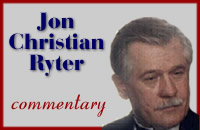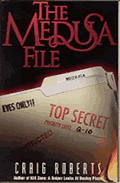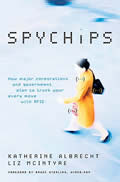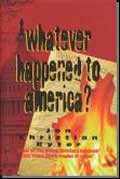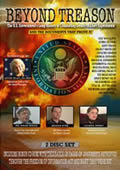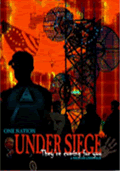Other
Ryter
Articles:
The Two Kerry's:
War Hero or
Traitor?
"Men in Black" The Cult of The Judges
REMEMBER
THE FLORIDA 'CHAD' FIASCO?
By Jon Christian Ryter
June 21, 2006
NewsWithViews.com
The Election of 2008 promises to dredge up all of the Freddie Kruger nightmares of the 1990s�Hillary, Bill and the ghoulish reincarnation of Al Gore, Jr. Only it isn't Nightmare on Elm Street�its Nightmare on Pennsylvania Avenue. For that reason, and because the voters of the United States have such short memories, one-by-one�one sin against the American people at a time�the American people need to be reminded, over-and-over again between now and Nov. 4, 2008, that the American people had three very dishonest people at the helm of the USS United States for 8 years. And rather than run the risk having either Hillary Clinton or Al Gore, Jr. in a position where they could steal the authority to steer the ship-of-state, (since neither could win it honestly) it is important that the voters of the United States have their memories jogged at every opportune moment between now and Nov. 4, 2008.
Even before the polls closed in Florida, on Nov. 7, 2000, the Democratic National Committee hired a Texas-based telemarketing company, TeleQuest, to take a push poll of every registered Democratic Palm Beach voter to find out if they were confused by the butterfly ballot. The purpose, of course, was not to find out who�if anyone�was really confused, but to line up potential claimants who would agree to sign affidavits that not only was the ballot confusing, but the voter was convinced that he or she had accidentally voted for Pat Buchanan. There had been absolutely no complaints initiated by voters that the ballot was confusing or misleading.
The DNC provided TeleQuest with a script. "Some voters," the script read, "encountered a problem today with the punch card ballots in Palm Beach County. These voters have said that they believe they accidentally punched the wrong hole for the incorrect candidate. If you have already voted and you think you may have punched the wrong hole for the incorrect candidate, you should return to the polls and request that the election officials write down your name so that this problem can be fixed."
Gore didn't like the DNC questionnaire. Neither did his campaign manager, Big Bill Daley. Hastily, they constructed a second one. It was much more personable, and made it appear as though friends of Gore were calling the voter. On Nov. 9, those called on the 7th and 8th were called again.
"I understand you were called yesterday by the Florida Democratic Party," the script began. (It would not bode well for the voter to learn that they were actually called by a telemarketing sales firm whose job it was to persuade them they had voted for the wrong person.) "I am following up today on behalf of the Gore-Lieberman Campaign. Would you be willing to answer a few questions?" If there was no objection, the telemarketer secured the voter's name, address, phone number, age, and just about anything else the voter was willing to share.
"Did you intend to vote for Gore-Lieberman, but think you may have voted for someone else?" The baited hooks was cast into the recently stirred waters of uncertainty. If the voter was not too alarmed, the next question was guaranteed to create doubt where none had previously existed. "Did you: punch the wrong hole, punch more than one hole, or was the ballot difficult to punch or mark?" And, finally, the crushing question: "Did you think to bring the confusion to the attention of a poll worker?"
Voters who weren't having a problem would not have brought the matter to the attention of a poll worker since they were unaware that a problem might exist. By November 9, hundreds of people who had voted for the candidate of their choice began to entertain serious doubts about whether or not they had voted correctly, or that they had properly dislodged the chad, thus possibly disqualifying their vote.
Within an hour or so of the polls closing on November 7, 2000 TeleQuest telemarketers were already laying the groundwork for the butterfly ballot flap that would start the Chad Dance in Southeast Florida. In a single 45 minute period between 7 p.m. and 7:45 p.m., over 5,000 registered Palm Beach County voters were contacted. The sales people from TeleQuest convinced over 1,000 voters that they may have voted for Pat Buchanan. By 10 p.m., every Democratic voter in Palm Beach County who could be reached had been contacted, and over 2,400 of them were persuaded they had accidentally voted for the wrong person. The groundwork for the Chad Dance was done. Gore was going to demand a recount. He needed to find 1,785 votes and, he decided, the best place to find those votes was in the counties that had voted most heavily for him.
There was only one thing wrong with Gore's plan to recount selected precincts in Palm Beach, Broward and Miami-Dade counties. He could not legally do it. And, what's more, he knew it. The laws of the State of Florida allow the loser of a contest within the State and/or counties to request a recount only if evidence of fraud could be proven. In any statewide race in Florida in which the defeated candidate lost by less than 1% of the vote a machine recount is mandated.. With 6+ million votes cast in Florida, Bush won the State by a margin of 1,784 votes-some 5 thousand votes short of a clear and incontestable victory.
By law in Florida, hand recounts are allowed only if there is evidence of mechanical failure or malfunction in the voting equipment-and, then, only when the sample hand recount reveals an error of sufficient magnitude to justify a hand audit. In the case of Gore, the established standards were obliterated, and the bar dropped so low that any finding in favor of Gore was deemed to be sufficient evidence that some type of malfunction or deliberate fraud had occurred.
In other words, intense pressure from the national Democratic Party level was applied on the county political machines to give the Gore team what it needed-enough votes to steal the election. When America's voters woke on Wednesday, November 8, Gore's TeleQuest campaign to confuse the voters in Palm Beach County was already in play. The Gore team and the media jumped on the manufactured confusion that not only did over 3,000 retirees of Palm Beach County accidentally vote for Pat Buchanan, 3,400 of them voted for both Buchanan and Al Gore, and another 15,000 of them cast ballots for both Gore and George W. Bush. In reality, what was happening was that someone was prepunching ballots before giving them to the voters.
The confusion about the butterfly ballot was so rampant that DNC spinmeisters tried to convince the nation that over 26 people per minute were so confused about the butterfly ballot that they voted twice for President. There were 19,200 double-punched ballots in Palm Beach County. There are approximately 100 voting precincts in that county. The high-error rate was concentrated in precincts controlled by Democratic voting officials.
Uniquely, the 4.14% double-punch rate in Palm Beach County was four times larger than it was in any other voting precinct in the United States using a punch card ballot. The double-punch rate in the presidential race in the rest of Florida was 1%. The double-punch error rate for the US congressional and senatorial candidates nationwide and in Florida was also 1%. What is even more strange is that in the precincts which experienced the 4.14% double-punch rate at the top of the ticket, the double-punches for the congressional and senatorial candidates mirrored the national average of 1%. The only explanation for the 4.14% double punch rate at the top of the ticket is that precinct workers were pre-punching the ballots before giving them to the voters. In Palm Beach County, Pat Buchanan did not have any supporters handing out ballots to voters standing in line to vote. All of the double punched ballots had a vote cast for Gore. There were no double-punched ballots for Buchanan and Bush�only Buchanan and Gore or Bush and Gore.
When the automatic recount added 643 Gore votes in Palm Beach, the Gore team was convinced that finding 328 more Gore votes would be fairly easy. When the sample hand count turned up only 4 additional Gore votes, the Gore team needed to buy more time--enough time to amass the support they would need to demand full recounts not only in Palm Beach County but Miami-Dade and Broward, the three liberal strongholds in southeastern Florida. Gore was convinced that in those counties he would find the votes he needed to win the election. The Chad Dance had officially begun.
After an electronic recount and one hand recount in the three heavily Democratic counties, the Gore team knew there weren't enough legitimate miscounts in the entire State to give Gore the votes he needed. Those votes could be gained only if the canvassing boards were allowed to discern the intent of over 6 thousand non-cast votes for president.
Gore's talking heads argued that nobody goes to the polls to vote in a presidential election and then declines to cast a vote for president. The simple truth is that 2% of the American people do just that in every presidential election�in every city, county and State in the nation. What Gore's spinmeisters were counting on was that the American people didn't know that.
And, the American people didn't know. Gore's talking heads successfully spun the perception that 2% of Florida's voters were denied a voice in naming the next President of the United States. Gore was going to unselfishly contest the Election of 2000 to make sure that every vote was counted. Since Gore already had a machine recount and a sample hand recount in three Florida counties, the Vice President needed to make sure the American people did not realize what he was doing as he tried to revote the ballots in three Florida counties.
Even though several hundred Floridians stepped forward to angrily protest that they had deliberately voted for "none of the above" by declining to vote for any of the presidential choices on the ballots, their voices fell on deaf ears. The talking heads shouted louder. The media was too busy defending those the invisible few whose votes may not have been counted to listen to those whose non-votes were about to be altered. The Chad dance was on, playing to the tune of Madam Butterfly. Change partners.
"I think we're setting a bad precedent," Supervisor of Elections Jane Carroll told Judge Robert W. Lee when talk about discerning voter intent first surfaced. The canvassing board, she told him had "...no business deciding whether a voter really intended to vote [for one candidate or another]. That's the reason," she concluded, "that I've never been in favor of this sort of thing before."
Lee, a very partisan Democrat, reluctantly agreed. Carroll and Lee both knew that it was one thing to look at a ballot and see a partially dislodged chad that should have been counted but had been rejected by the machine counter. It was another to look at an un-voted ballot and decide if the voter actually intended to vote for a candidate he or she obviously had not inteded to vote for simply because a chad might look dimpled or, if held at a certain angle, a sliver of light might be visible. What troubled Carroll most was not that she was being asked to discern the voter's intent, it was that she had discerned Gore's intent. And it had nothing to do with counting the votes. It had to do with re-voting them.
Most troubling of all was that the canvassing boards were entering a realm in which there were no written guidelines since the provision in Florida law concerning voter intent (Section 102) were written prior to the advent of the machine ballot and dealt entirely with handwritten ballots. Since the voter was required to make a mark of some sort on a ballot, discerning voter intent was not difficult. If the voter intended to cast his or her ballot for a particular candidate, a mark of some sort would necessarily show on the ballot. For example, if the voter used a blue ink pen instead of the soft black lead pencil provided by the precinct, the scanners which read the ballots would not see the blue ink, but a hand counter reviewing the ballot would. Or, if the voter was told to color in the entire box but marked it with an "X" the canvassing board member looking at the ballot would still be able to easily determine that the voter intended to vote for that candidate.
But along the Gold Coast, the canvassing boards were being asked to apply Section 102 to a ballot that did not exist when the statute was written, and to use pencil standards to determine voter intent when the voter used a stylus to punch out chads that theoretically remained intact. They were expected to discern voter intent by sheer guesswork.
And, guesswork alone was what was used-not exactly what the State legislature had in mind when the Electronic Voting Systems Act of 1973 was enacted. As each day passed, the standards for determining if someone had voted for Al Gore were lowered, until it reached the point if the canvassing board member could see a glimmer of light penetrating through the ballot on the Gore chad, it was a vote for Gore. Detached chads on the Bush slot were largely ignored unless contested by Republican observers. Ballots were twisted and manhandled to the point that the floor around the board members examining the ballots were littered with dislodged chads. The longer the board members examined the ballots, the easier it was to find a Gore vote in the non-voted ballots.
On Saturday, November 11, 2000 James A. Baker III held a press conference to announce that Texas Governor George W. Bush had filed suit in in US District Court to block any further attempts on the part of Vice President Al Gore to seek any additional recounts in the State of Florida. Baker reminded the media that Gore had promised the American people that he would concede if the automatic machine recount confirmed Bush's victory. It did. He didn't. Second, he told the American people that he would concede the election if hand sampling supported the machine count. It did. He didn't.
Even though a majority of Americans polled by the various news agencies wanted, and expected, Gore to concede at that point, the Bush team knew Gore was in the race until he ran out of legal options or until he had recast enough votes to be declared the winner. This race was not coming down to the checkered flag. It was only in the second lap. And Bush, who was less than a car-length ahead, knew it.
Gore's lawyers had already initiated legal action to push back the State-mandate certification deadline to give him time to recast undervoted and overvoted ballots in Palm Beach, Miami-Dade and Broward Counties in search of the votes he needed not only to overcome the paper-thin lead Bush held on the 12th, but to overcome what the Gore people knew would be an avalanche of Bush military votes on the 15th. It was a herculean task, but Gore was up to it. As he told his aides at that time: "I am destined to be the leader of the free world�I will prevail."
|
Subscribe to the NewsWithViews Daily News Alerts! |
The
telemarketing sales people at TeleQuest had done their job well.
Their sales pitch on the unsuspecting people in Palm Beach County started
the Chad Dance as the Democratic machine attempted to revote the Election
of 2000 for a man who was "talent-spotted" by the People's Liberation
Army in 1988 as a potential American president. After bowing out of
his exploratory campaign to grab the Democratic nomination in 1988,
Senator Gore began his quest for the 1992 nomination in 1989 when he
accepted the invitation of PLA Chinese operative Maria Hsia to visit
the Fo Kuang Shan Buddhist Monastery in Kiaoshung, Taiwan to
received wisdom�and, it appears, a little cash�from Master Hsing Yun
and the People's Republic of China. (According to Edward Timberlake
and William C. Triplett in their 1998 book, "Year of the Rat,"
the Fo Kuang Shan Buddhist Monastery was a PLA spy stronghold.
Most of the espionage carried out in Taiwan by Beijing was done by the
"monks." Master Hsing Yun created a money conduit to Gore through the
Hsi Lai Buddhist Temple in Hacienda Heights, California, wiping out
another Gore myth that the Vice President thought his visit to the Temple
in the summer of 1994 was a community outreach visit, not a fundraising
event where nuns who had sworn vows of poverty contributed $50 thousand
to the Clinton-Gore reelection campaign.)
� 2006 Jon C. Ryter - All Rights
Reserved
[Read Jon Ryter's book "Whatever Happened to America?"]
Sign Up For Free E-Mail Alerts
E-Mails
are used strictly for NWVs alerts, not for sale
Jon Christian Ryter is the pseudonym of a former newspaper reporter with the Parkersburg, WV Sentinel. He authored a syndicated newspaper column, Answers From The Bible, from the mid-1970s until 1985. Answers From The Bible was read weekly in many suburban markets in the United States.
Today, Jon is an advertising executive with the Washington Times. His website, www.jonchristianryter.com has helped him establish a network of mid-to senior-level Washington insiders who now provide him with a steady stream of material for use both in his books and in the investigative reports that are found on his website.
E-Mail: BAFFauthor@aol.com
There was only one thing wrong with Gore's plan to recount selected precincts
in Palm Beach, Broward and Miami-Dade counties. He could not legally do
it. And, what's more, he knew it.

